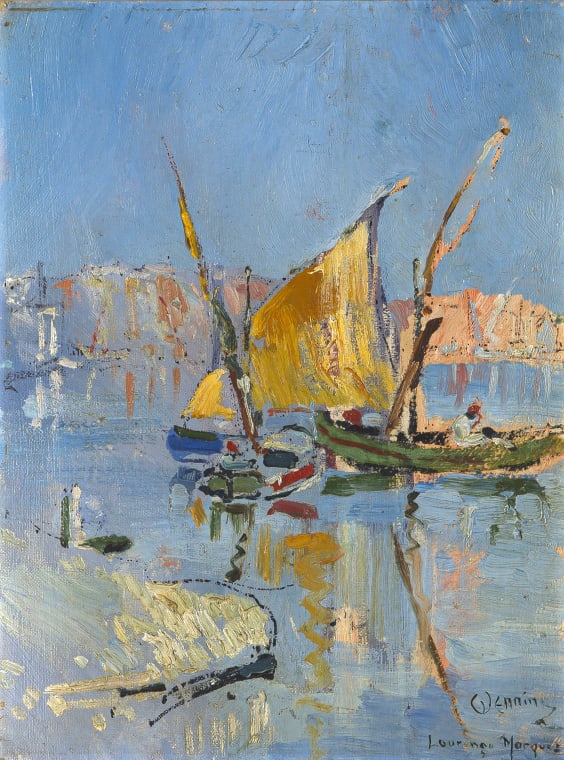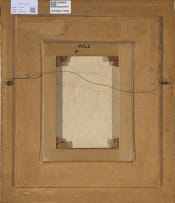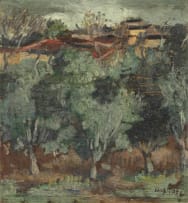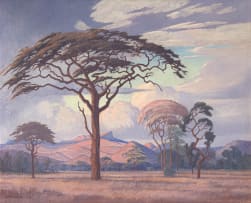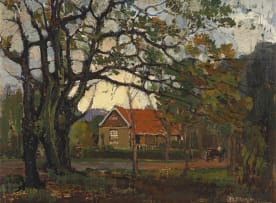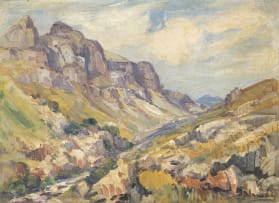Modern and Contemporary Art
Live Virtual Auction, 28 March 2023
Evening Sale
Incl. Buyer's Premium & VAT
About this Item
signed and inscribed with the title
Notes
Pieter Wenning was born and grew up in the Netherlands and developed a love of painting from an early age as his father was an art dealer and sold artist's materials. Wenning's art teacher at school identified the young boy's obvious talent and became his first mentor. He introduced Wenning to the Dutch masters, and the tradition of European painting, and tried to persuade Wenning's parents to allow him to pursue a career as an artist, but his parents discouraged him from studying art and he went to work for the national railway company instead, however painting remained his focus and he spent all his spare time painting and drawing. An offer of a job at a book dealer in South Africa brought Wenning and his family to Pretoria in 1905. After some years of frugality and careful savings, he was able to import an etching press, and pioneered the medium in this country, while also drawing incessantly and beginning to experiment with painting in oils.
With J H Pierneef and George Smithard, he was a founder member of the Individualists in 1911, a group of like-minded artists who exhibited their work together in Pretoria. Wenning was always dogged by financial problems but with the help of D C Boonzaier and several other friends who provided the funds, he spent three months in the Cape in 1917, and produced enough paintings to mount a private exhibition. His work was well-received, with almost all being sold, but the art market was depressed as a result of WWI and Wenning struggled to achieve good prices.
Esmé Berman described how Wenning 'found himself' as an artist in the Cape, not only because he was then painting full-time, but also because the gentler climate and 'shades of dampened green' familiar from his homeland suited him better than the 'elusive ochres of the Highveld'.1 The artist worked relentlessly 'en plein air', regardless of the weather and with little concern for his health, but nevertheless, also managed to produce a significant number of still life's, which Berman considers as equal to, if not more important than, his landscapes. For Wenning, still lifes were essays in 'colour form and composition … governed less by the influence of Dutch precedents than by the lessons gained from Oriental art'.2
Wenning died at the age of 47 of tuberculosis, but despite his relatively short career he produced over 300 paintings in addition to his drawings and etchings. When he died, he was probably the most important artist that the country had known. His work is included in the collections of the Iziko South African National Gallery in Cape Town, the Pretoria Art Museum, the Johannesburg Art Gallery, the William Humphreys Gallery in Kimberley, and the Wits Art Museum, among others.
Pieter Wenning's unique gifting as a painter is evident in these five works on offer. His style fused cool European observation with a lively flickering palette of rich colours, exquisite line work and tonal study.
This excitement of subject and vitality of application makes works such as Laantjie Nuweland (lot 19) a joy to observe. Red Roofed Cottage, Autumn, (lot 18) is another typical Cape subject which no doubt inspired a young Gregoire Boonzaier to find and capture similar subjects. Lorenço Marques (lot 22) shimmers in a tropical haze where dhows cast golden and ochre reflections on a torpid azure sea.
Still Life with Oriental Vases and Chinese Dog of Fo (lot 21) and Vase and Figurine (lot 21) display how under Wenning's skilful brush, and through the deployment of oriental porcelain and figurines he was able to conjure the most arresting still lifes seen in South Africa in the early 20th century.
1. Esmé Berman (1983) Art & Artists of South Africa, Cape Town: AA Balkema, page 497.
2. Ibid, page 498.
Provenance
Mr and Mrs AJ ter Beek, Johannesburg.
Private Collection.
Literature
Gregoire Boonzaier and Lippy Lipshitz (1949) Wenning, Cape Town: Unie-Volkspers Beperk, illustrated plate 66.
